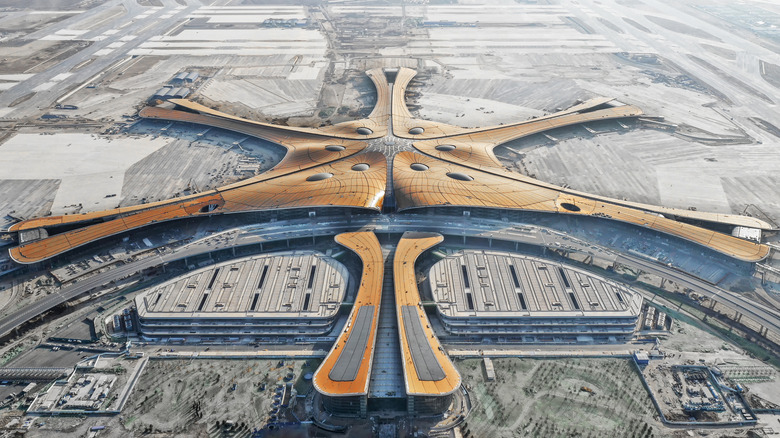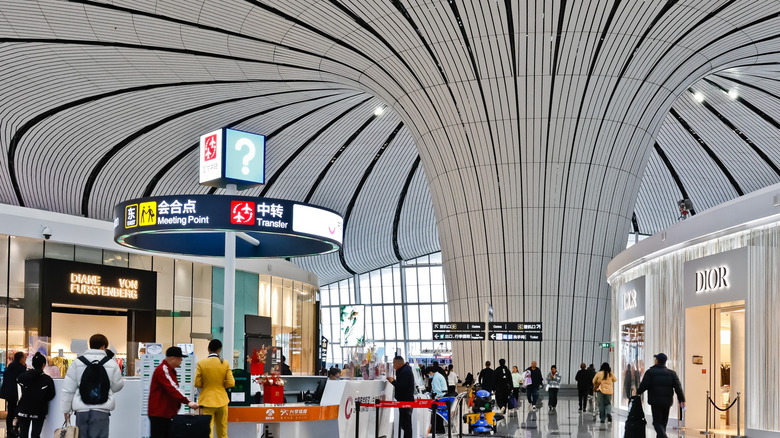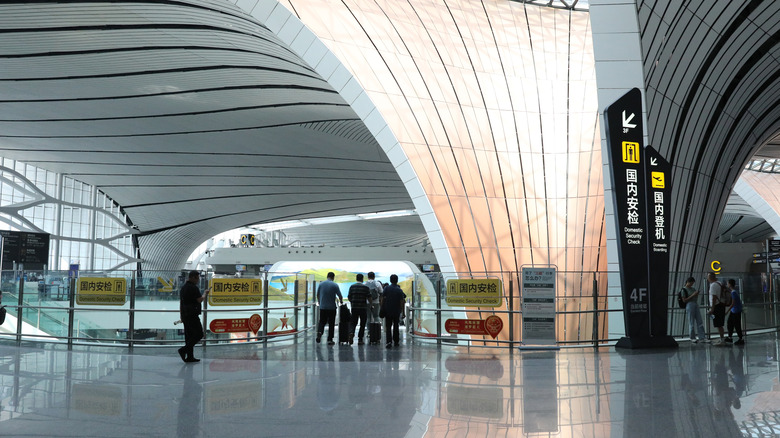The World's Largest Airport Terminal Is An Architectural Masterpiece With A Unique Layout
We may receive a commission on purchases made from links.
In an unexpected flip on the saying, "What's old is new again," the massive terminal at Beijing Daxing International Airport (PKX) is hailed for its one-of-a-kind design. But if you look closely, you may notice the state-of-the-art building that opened in 2019 looks an awful lot like a landmark mid-century New York City airport terminal: the TWA terminal at New York-JFK. Like Beijing's newest airport, the NYC airport terminal-turned-hotel originally featured a hub-and-spoke layout — a central terminal with aircraft gates located along corridors leading from a common landside hub. When it was completed in 1962, the innovative design of TWA's New York terminal was considered groundbreaking, but more than six decades later, it looks charmingly vintage compared to Beijing Daxing International Airport.
Often described as being shaped like a starfish (a bit of a misnomer given the design features six, not five, spokes), the 7.5 million-square-foot behemoth (that's a smidgeon bigger than a ¼-square-mile) is the largest single-building airport terminal in the world. Single-building is a key point in this context; officially, Istanbul Airport (IST) is the biggest airport in the world. Designed by London-based Zaha Hadid Architects in conjunction with ADP Ingénierie, a sustainable engineering consultancy that specializes in airport design, Beijing Daxing's hub-and-spoke layout was actually designed to represent the traditional Chinese architectural philosophy of connecting individual spaces through a central courtyard. The result is a multiple award-winning transportation mega-complex where passengers are never more than an eight-minute walk from their boarding gate — though the airport's myriad distractions may slow your stroll. If you don't have access to an airline VIP lounge, Beijing Daxing offers plenty of ways to pass the time, including a wide array of dining and shopping options in addition to its Zen-inducing relaxation space.
Dining and shopping in a futuristic airport
Built over a period of five years beginning in 2014, Beijing Daxing has been described as an architectural wonder. The goal of the project was twofold. First, it was planned to replace China's outdated Nanyuan Airport, which opened in 1910 during the Qing Dynasty; second, it was designed to ease traffic at Beijing Capital International Airport (PEK). During peak construction, more than 40,000 construction workers were on-site building the $17 billion airport. With architectural features including a glass-and-steel design with an iridescent shell and convex skylights to maximize natural light, the passenger-friendly transportation hub is also a stunning landmark.
In terms of the passenger experience, Beijing Daxing has been described as futuristic. We're on the fence about the customer-service robots that are on-site to provide travelers with flight updates, airport information, and even assist drivers in the airport's carpark, but as long as they're more effective than "please listen closely because our options have changed" help lines, we're keeping an open mind.
On the other hand, we're hands-down in favor of the airport's other amenities, like the on-site yoga room and the Zen-inducing traditional gardens located at the end of each of the airport's five gate corridors. And while you won't currently find any celebrity chef-affiliated dining venues at Beijing Daxing, you will find 70 bars, restaurants, and coffee shops, including a few familiar (to Westerners) names like Starbucks, KFC, and Pizza Hut, in addition to brands like Japan's Ajisen Ramen and China's Laoshe Teahouse. There's also a Godiva shop if you're looking for sweet treats to satisfy a mid-flight chocolate craving or to fuel up before a last-minute duty-free shopping frenzy. Traveling alone? Opt to spend between-flight downtown at one of several day spas and salons. There's also a playground for families traveling with children.
Plenty of ways to pass time between flights
When it opened in 2019, Beijing-Daxing was expected to serve 72 million passengers annually by 2025. In August 2024, annual traffic, including inbound and outbound passengers, for the calendar year had exceeded 30 million, a 31% year-over-year increase over the same period in 2023. If all goes according to plan, the airport is expected to serve up to 100 million passengers annually by 2040. In 2019, the airport opened with four runways, but the forward-facing master plan paves the way for an additional three runways to be constructed as traffic increases. Earlier, we mentioned the six-armed starfish shape of the facility; that includes five corridors leading to boarding gates. The sixth leads to a state-of-the-art transportation hub that offers transfers via taxi or bus in addition to connections to local train service and access to China's national high-speed rail network, which is capable of whisking patrons between the airport and downtown Beijing in just 20 minutes.
That's good news for commuters and visitors, but it's also an added perk for passengers on extended layovers because the transportation hub makes it easy to skip out for a few hours to explore the local sights. Beijing Wildlife Park, for example, is about 20 minutes from the airport by taxi. Passengers on layover who are interested in exploring some of Beijing's top attractions —including the Temple of Heaven and Forbidden City — can confidently get there and back via taxi, rail, subway, or bus. If you set out to explore, it's probably a good idea to have a Chinese phrase book in your pocket.
On the other hand, an extended layover may be the perfect opportunity to get a bit of shut-eye — especially if you're traveling long-haul in a coach seat. A five-minute walk from the airport's central check-in desks, accessed via the corridor that also leads to the transportation hub, to the in-airport Aerotel Beijing offers private rooms (with showers) starting at about $50 per hour. Bookings grant access to the hotel's fitness center and Library Lounge, where amenities include a beverage menu, an à la carte menu, and scheduled buffet service. And, if you're wondering what happened to the now-retired Nanyuan Airport replaced by Beijing-Daxing, there's been talk about reopening the facility as an aviation museum.


